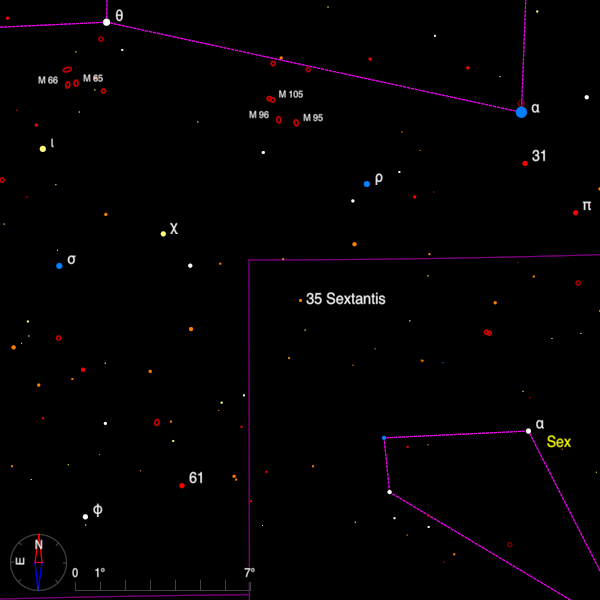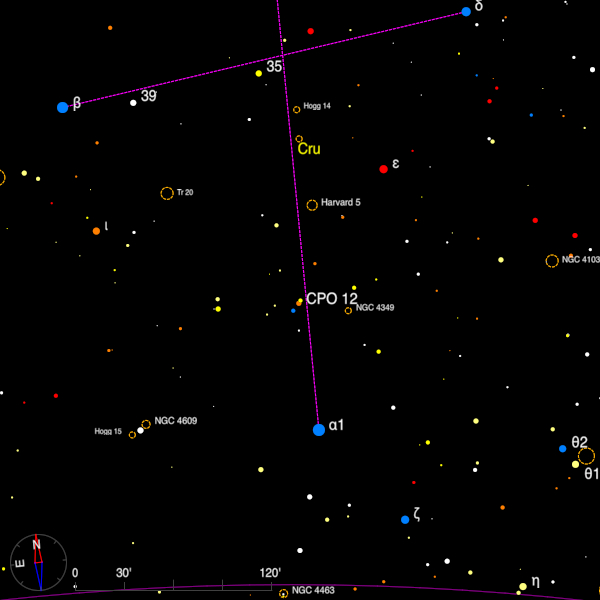Double Star of the Month in Crux
-
April 2021 - Double Star of the Month
35 Sex (10 43 20.91 +04 44 51.6) lies south of the main body of the constellation of Leo and about 5 degrees SSE of the magnitude 3.9 star rho Leonis. It is a fine pair with the principal stars shining at magnitudes 6.2 and 7.1 and the current separation of 6".8 puts the pair within range of small apertures.

A finder chart for the double star 35 Sextantis in Sextans created with Cartes du Ciel. The angular motion in 2 centuries has amounted to about 2 degrees with the stars closing in very slowly. There seems to be no doubt that this is a binary pair - the Gaia EDR3 parallax data show that they are at 687 and 718 light-years respectively each with a formal error of about 22 light-years. Each star appears to be an early K giant which would imply that they should appear orange or deep yellow. Webb found colours of yellow and blue and later yellow and ruddy and noted that there was
Much difference as to colours
.Just over 5.5 arc-minutes away from AB in PA 210 degrees is a star of magnitude 8.1, which is the long period binary A 2769 - 8.4, 9.4, 207 degrees, 0".5.
Nestling within the bounds of the five main bright stars of Crux, CPO12 (12 28 16.88 -61 45 55.6) can be found 1.5 degrees N. of alpha Crucis (Acrux) and 20 arc-minutes east of the open cluster NGC 4349. The stars are V magnitudes 7.3 and 8.2 and with a current separation of 2".1 they can be easily seen in 75 to 100-mm aperture.

A finder chart for the double star CPO 12 in Crux created with Cartes du Ciel. Since the pair was discovered in 1880 the position angle has reduced from 271 degrees to 183 degrees and a preliminary orbit by Dr. Andrei Tokovinin suggests that the period is about 690 years. In 1939, Robert Rossiter, using the 27-inch refractor at Bloemfontein in South Africa, noted that the B star was a close double. The Washington Double Star Catalog (WDS) gives a magnitude of 8.8 for each component. This is also a binary system but the stars are about ten times closer than A-B. The period is 28 years and the stars are currently 0".18 apart. By 2030 they will have reached their maximum separation of 0".24. There is another, much fainter companion - a star of magnitude 13.7 at 331 degrees and 7".9.
Acrux, of course, is a magnificent pair - see the column for April 2007 for more details.
Bob Argyle - Double Star Section Director
-
Double Star of the Month - April 2012
In this series of short articles, a double star in both the northern and southern hemispheres will be highlighted for observation with small telescopes, with new objects being selected for each month.
2 CVn = STF1622 (12 16 07.55 +40 39 36.6) is a beautiful pair with components of contrasting hues which sits near the western border of Canes Venatici with Ursa Major and about 5 degrees following beta CVn. The primary star, an early M giant is accompanied by a late F dwarf and many writers have commented upon the colours to be seen here: - Webb called them very gold and blue, Dembowski thought them yellow and azure, Franks made them orange and blue and more recently Sissy Haas recalled brick red and silvery sapphire. The stars are magnitudes 5.9 and 8.7 and are currently separated by about 11".4 which makes them an easy target even for the small telescope.
mu Crucis (12 54 35.66 -57 10 40.4) is simply one of the most beautiful doubles in the sky. A pair whose components of visual magnitude 3.9 and 5.0 share common proper motion and distance, this system belongs with the Scorpio OB2 association of young hot stars, and Hipparcos places both stars about 412 light years away. Shatsky and Tokovinin used the ADONIS near infrared adaptive optics system on the ESO 3.6-metre reflector to search for faint, close companions and they found two objects within 5" of component B. No magnitudes or proper motions are available so it is too early to say if these are physically connected but the two bright stars certainly form a very long period binary. Mu Crucis was found by Dunlop in 1826. The spectral types are both B and Hartung record them as both white whereas Richard Jaworski sees a tinge of yellow in the fainter star. The current separation of 35" and the brightness of the stars almost makes this a southern equivalent of Albireo but without the colours.
Bob Argyle - Double Star Section Director
-
Double Star of the Month - April 2007
In this series of short articles, a double star in both the northern and southern hemispheres will be highlighted for observation with small telescopes, with new objects being selected for each month.
Although not strictly a northern pair, gamma Virginis (12 41 40.0 -01 26 58) is one of the most spectacular pairs in the sky and the recent close approach, the first for almost 170 years, excited some interest in double star aficionados. The pair was certainly noted by Bradley in 1718 when the separation was about 6 arc seconds, the stars closed slowly until the 1830s when the motion accelerated considerably. It attracted the attention of Sir John Herschel who applied the new science of orbital analysis to the pair but his first attempt did not represent the observed motion. By 1835 the separation was down to 1 arc second, and in the UK Dawes and Smyth made measurements of the pair, whilst F.G.W.Struve, using the 9.6-inch Fraunhofer refractor at Dorpat also followed events. In early 1836, Herschel found the star single with the 20-foot reflector at the Cape and in the spring Struve found an elongation, giving a separation of 0.25 arc seconds. The pair rapidly widened from then on reaching 2 arc seconds by 1843. Since the recent closest approach of 0.37 arc second in mid-2005 the separation has now increased to 0.74 arc second at PA 53 degrees (2007.3) with the angular motion about 2 degrees per month at present. Both stars are F0 dwarfs and appear yellow to the telescope user. A 6-inch telescope should almost resolve them, while an 8-inch will definitely do so.
The small and bright constellation of Crux bestrides the meridian in southern latitudes during the late evening in April. The brightest star, alpha or Acrux, (12 36 35.9 -63 05 57) is one of the most spectacular pairs in the sky and is accessible to small telescopes. Discovered by Jesuit priest-astronomers in Siam in 1685, it was measured by Dunlop in 1826 who found a separation of 5.4 arc seconds and a PA of 86 degrees. There has been a small decrease in distance to 4.0 arc seconds and an increase in PA to 114 degrees at the time of writing. The two stars form a binary pair and the bright 5th magnitude star HR 4729 some 90 arc seconds away also shares in the proper motion. According to Andrei Tokovinin, all 3 stars are spectroscopic binaries and coronagraphic imaging of the distant companion shows three very faint stars close to C of which one, some 2 arc seconds distant may be physical. If so, then Acrux is a septuple system. The three visual components of Acrux are luminous B stars and therefore appear blue-white in the telescope. The Hipparcos satellite determined a parallax for alpha1 equivalent to a distance of 321 light years with an uncertainty of about 21 light years.
Bob Argyle - Double Star Section Director